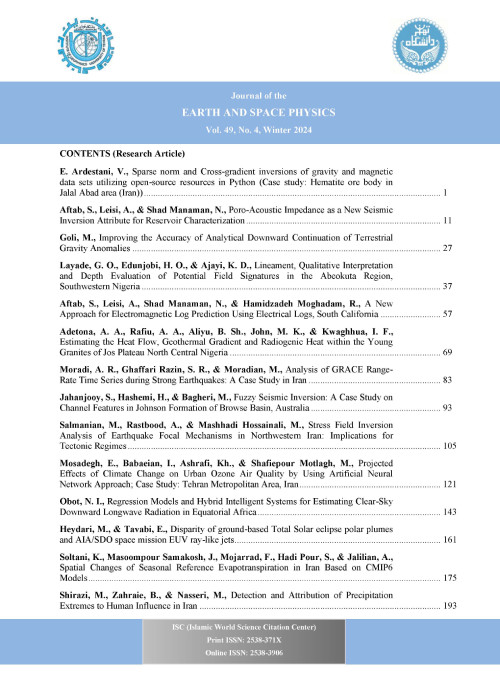Assessment of the application of the Stokes parameters to investigation of inertia-gravity waves properties
Author(s):
Abstract:
Advantages and disadvantages of using “Stokes parameters” in exploration of inertia-gravity wave properties are discussed in this paper. The survey is carried out on an inertia-gravity wave event (IGWs in what follows) that occurred over Iran from 7 to 9 February 2012. Applying this technique for investigation of atmospheric IGWs was recommended by Vincent and Fritts (1987) and then developed by Eckerman and Vincent (1989).The methods of Stokes parameters and hodograph (as the traditional methods) were used for estimation of IGW characteristics by Lue and Kuo (2012) in an idealized simulation study and Lue et al. (2013) in a real case study. It was proved that there were limitations and errors in intrinsic period and horizontal propagation direction especially when data consists of both upward and downward propagating waves. Zülicke and Peters (2006) calculated the horizontal divergence field using MM5 simulated data in an IGW event occurring in a poleward breaking Rossby wave and compared results with the application of Stokes parameters. It was shown that while using the divergence eliminates the background field, the exploitation of Stokes parameters strongly depends on the way that the background is removed. The case chosen for the current survey had previously been studied using the horizontal divergence and the hodograph methods. The data used for this study were obtained from radio soundings launched from five upper-air stations in Iran throughout the mentioned event. IGWs structures were identified by fluctuation in temperature and wind fields after removing the background flow. The removal is performed either by fitting a sixth-degree polynomial or applying a bandpass Lanczos filter. In order to avoid arbitrary choices of inappropriate filter parameters, wavelet analysis software provided by Torrence and Compo (1998) has been applied to the interpolated data (with equal vertical-space points of 100 m before background removal). Based on previous studies (Spiga et al., 2008 and Serafimovich et al., 2005) the Morlet wavelet Function is chosen for this purpose. Preliminary wavelet analysis shows that a typical vertical wavelength of 4-8 km is dominant in wind profile (also, a wavelength of 2-4 km is detected in the lower stratosphere in some cases). To facilitate the conduct of the study and avoid the adverse effects of strong wind speed in the vicinity of the jet stream, the vertical profiles were separated into two sections of troposphere (from 3 to 9 km in altitude below the jet stream) and lower stratosphere (from 14 to 27 km, above the jet stream). The intrinsic frequencies estimated using Stokes parameters imply that this method (like hodograph method) is usually unable to detect the high-frequency part of IGW spectra. In addition, a great uncertainty appeared when a polynomial fitting was used to separate perturbation from the mean field. Furthermore, the effects of background winds prevent accurate estimation of horizontal direction of wave propagation. Indeed, the technique can distinguish neither the eastward (northward) from westward (southward), nor upward from downward energy propagation. Nevertheless, the concomitant use of “Stokes parameters” and “Rotary Spectrum” shows satisfactory results. In addition to reducing the amount of computation (using only two Fast Fourier Transformation (FFT) in comparison with five FFTs in conventional calculation), calculating rotary spectrum directly from Stokes parameters suggests that upward propagation of energy prevails over downward propagation in the stratosphere and more importantly in the troposphere. Energy of the wave can be determined from the fluctuation fields. The ratio of estimated potential energy to kinetic energy is greater than 1 in the troposphere and less than 1 in the lower stratosphere. It implies that there is a great energy source of IGWs in the troposphere which is compatible with previous numerical simulations of this case undertaken by the authors.
Keywords:
Language:
Persian
Published:
Journal of the Earth and Space Physics, Volume:41 Issue: 3, 2015
Pages:
525 to 533
magiran.com/p1489942
دانلود و مطالعه متن این مقاله با یکی از روشهای زیر امکان پذیر است:
اشتراک شخصی
با عضویت و پرداخت آنلاین حق اشتراک یکساله به مبلغ 1,390,000ريال میتوانید 70 عنوان مطلب دانلود کنید!
اشتراک سازمانی
به کتابخانه دانشگاه یا محل کار خود پیشنهاد کنید تا اشتراک سازمانی این پایگاه را برای دسترسی نامحدود همه کاربران به متن مطالب تهیه نمایند!
توجه!
- حق عضویت دریافتی صرف حمایت از نشریات عضو و نگهداری، تکمیل و توسعه مگیران میشود.
- پرداخت حق اشتراک و دانلود مقالات اجازه بازنشر آن در سایر رسانههای چاپی و دیجیتال را به کاربر نمیدهد.
In order to view content subscription is required
Personal subscription
Subscribe magiran.com for 70 € euros via PayPal and download 70 articles during a year.
Organization subscription
Please contact us to subscribe your university or library for unlimited access!



